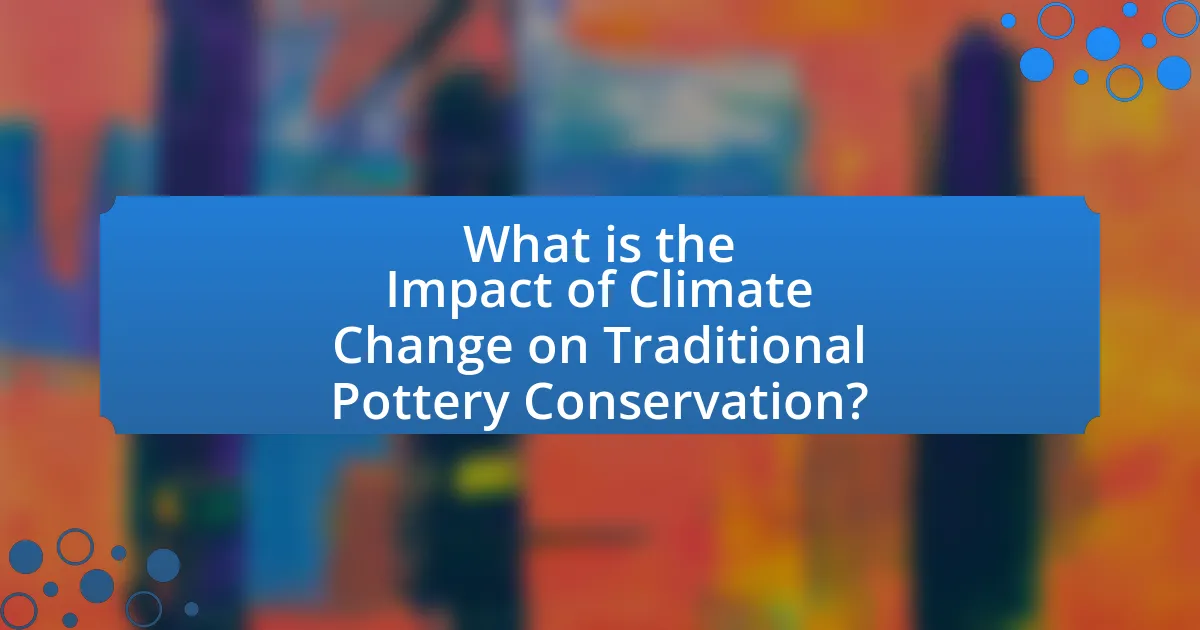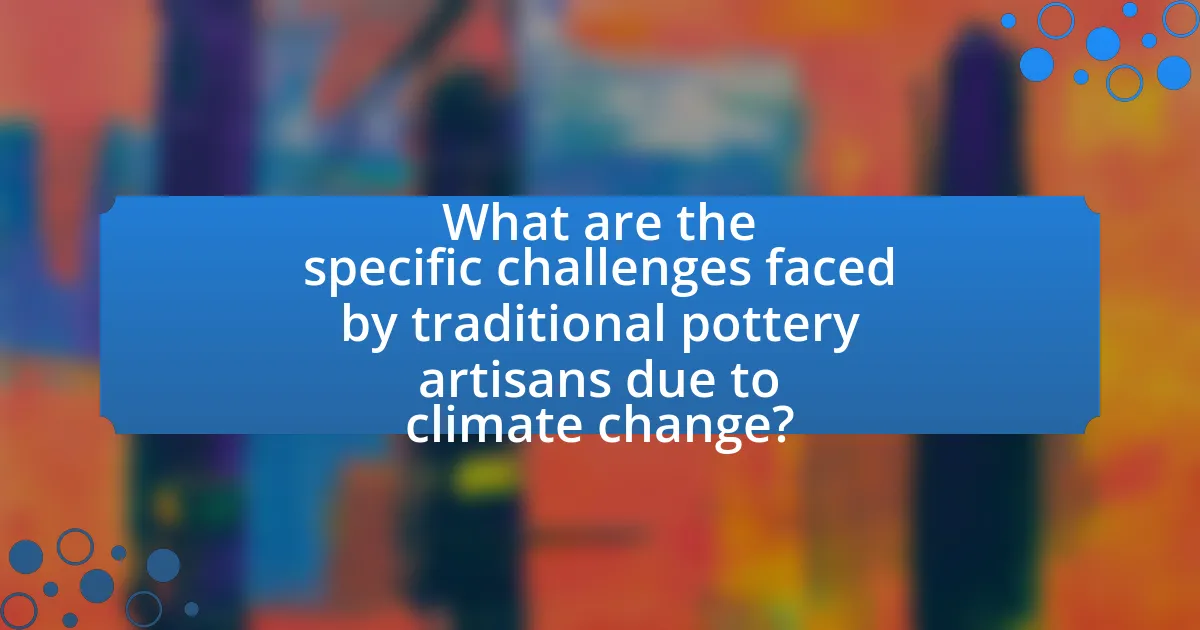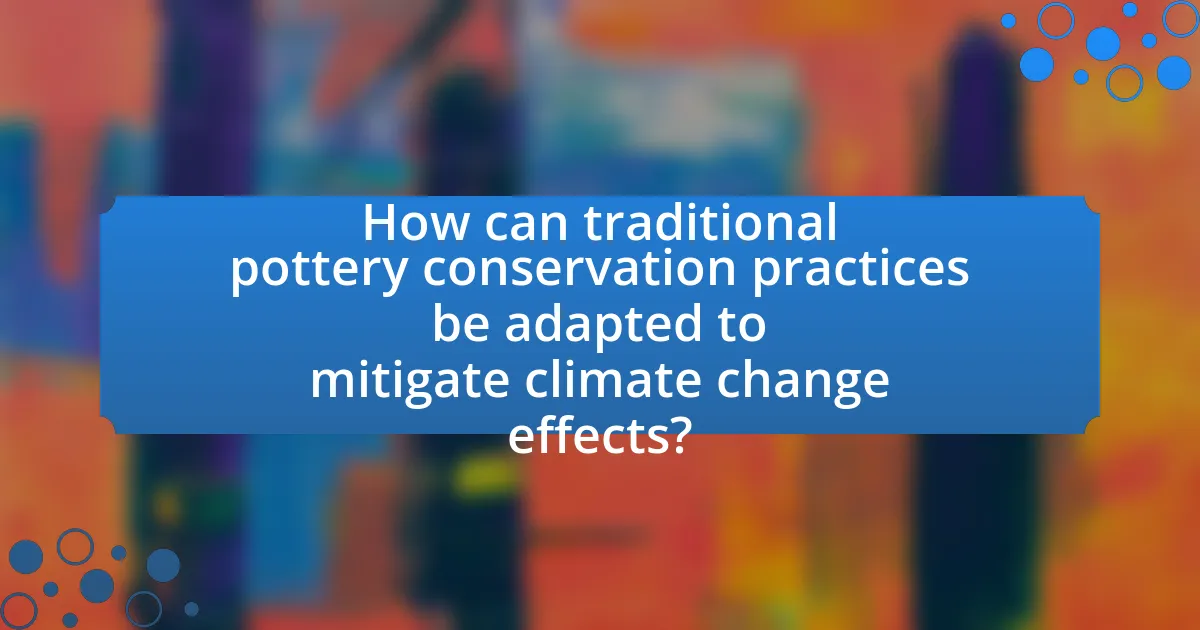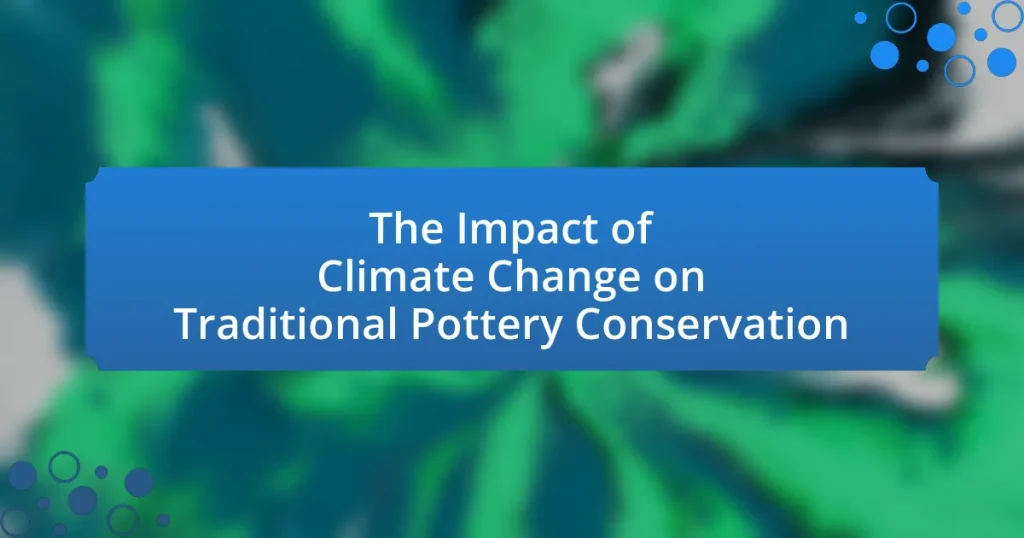The article examines the impact of climate change on traditional pottery conservation, highlighting how altered environmental conditions threaten the preservation of clay materials and firing processes. It discusses the degradation of clay sources, increased humidity leading to mold growth, and the physical damage caused by extreme weather events. The article also addresses the challenges faced by pottery artisans, including resource scarcity and the need for adaptation in conservation practices. Furthermore, it explores innovative techniques and sustainable practices that can enhance the longevity of pottery in a changing climate, emphasizing the importance of community awareness and support for traditional artisans.

What is the Impact of Climate Change on Traditional Pottery Conservation?
Climate change negatively impacts traditional pottery conservation by altering environmental conditions essential for the preservation of clay materials and firing processes. Increased temperatures and erratic weather patterns can lead to the degradation of clay sources, affecting their plasticity and workability. Additionally, rising humidity levels can promote mold growth on pottery, while extreme weather events can physically damage pottery artifacts. Research indicates that these environmental changes threaten the integrity of traditional pottery techniques, as artisans may struggle to adapt to new conditions, ultimately risking the loss of cultural heritage associated with these crafts.
How does climate change affect the materials used in traditional pottery?
Climate change affects the materials used in traditional pottery by altering the availability and quality of clay and other natural resources essential for pottery production. Increased temperatures and changing precipitation patterns can lead to soil erosion and degradation, impacting clay deposits. For instance, studies indicate that rising temperatures can cause clay to dry out more quickly, making it less workable and affecting the final product’s durability. Additionally, extreme weather events, such as floods or droughts, can disrupt the harvesting of raw materials, leading to inconsistencies in the quality of pottery materials.
What specific materials are most vulnerable to climate change?
Ceramic materials, particularly traditional pottery, are most vulnerable to climate change due to their sensitivity to temperature fluctuations and humidity levels. High temperatures can cause thermal stress, leading to cracking and structural failure, while increased humidity can promote the growth of mold and mildew, which can damage the surface and integrity of the pottery. Additionally, the chemical composition of clay and glazes can be altered by environmental changes, affecting their durability and aesthetic qualities. Studies have shown that ceramics exposed to extreme weather conditions exhibit significant degradation, highlighting the need for protective measures in conservation efforts.
How do temperature and humidity fluctuations impact these materials?
Temperature and humidity fluctuations significantly affect traditional pottery materials by causing physical and chemical changes. High temperatures can lead to thermal expansion, which may result in cracking or warping of the pottery, while low temperatures can cause brittleness. Additionally, increased humidity can promote moisture absorption, leading to efflorescence or mold growth, which deteriorates the pottery’s surface. Research indicates that ceramics are particularly vulnerable to these environmental changes, as evidenced by studies showing that fluctuations can reduce the structural integrity of pottery over time, necessitating more frequent conservation efforts.
What are the broader implications of climate change for pottery conservation practices?
Climate change significantly impacts pottery conservation practices by altering environmental conditions that affect the stability and preservation of ceramic materials. Increased humidity and temperature fluctuations can accelerate the deterioration of pottery, leading to issues such as cracking, warping, and the growth of mold. For instance, studies have shown that higher temperatures can increase the rate of chemical reactions that degrade pottery glazes and bodies, compromising their structural integrity. Additionally, climate change can lead to more extreme weather events, such as flooding, which can physically damage pottery collections stored in vulnerable locations. These factors necessitate the adaptation of conservation strategies to include climate-resilient materials and methods, ensuring the long-term preservation of pottery artifacts in changing environmental conditions.
How are traditional conservation methods challenged by climate change?
Traditional conservation methods are challenged by climate change due to increased temperature fluctuations and humidity levels that can accelerate the deterioration of materials used in pottery. For instance, rising temperatures can lead to thermal expansion and contraction, causing cracks and structural weaknesses in pottery artifacts. Additionally, higher humidity can promote mold growth and chemical reactions that further degrade organic materials and glazes. Research indicates that climate change is expected to increase the frequency of extreme weather events, which can lead to flooding and other environmental stresses that threaten the integrity of pottery collections.
What adaptations are necessary for effective pottery conservation in a changing climate?
Effective pottery conservation in a changing climate requires adaptations such as controlled storage environments, humidity regulation, and the use of advanced materials for restoration. Controlled storage environments help mitigate the effects of temperature fluctuations and humidity changes, which can lead to deterioration of pottery. Humidity regulation is crucial, as excessive moisture can cause mold growth and physical damage to ceramic materials. Additionally, employing advanced materials, such as synthetic adhesives and protective coatings, enhances the longevity of restored pottery by providing better resistance to environmental stressors. These adaptations are supported by research indicating that climate change significantly impacts the physical and chemical stability of ceramic artifacts, necessitating proactive conservation strategies.

What are the specific challenges faced by traditional pottery artisans due to climate change?
Traditional pottery artisans face several specific challenges due to climate change, including altered clay properties, increased water scarcity, and extreme weather events. Changes in temperature and precipitation patterns can affect the availability and quality of clay, making it more difficult for artisans to source suitable materials. Water scarcity, exacerbated by climate change, limits the ability to mix and mold clay effectively, impacting the production process. Additionally, extreme weather events, such as floods or droughts, can disrupt traditional firing methods and damage finished products, leading to economic losses for artisans. These challenges threaten the sustainability of traditional pottery practices and the livelihoods of those who rely on them.
How does climate change influence the availability of traditional pottery resources?
Climate change significantly influences the availability of traditional pottery resources by altering the natural environments where essential materials, such as clay and water, are sourced. Increased temperatures and changing precipitation patterns can lead to soil erosion, reduced clay deposits, and diminished water supplies necessary for pottery production. For instance, studies have shown that regions experiencing prolonged droughts face challenges in accessing quality clay, which is critical for traditional pottery making. Additionally, climate change can disrupt the ecosystems that support the growth of plants used in pottery decoration, further impacting the craft’s sustainability.
What resources are becoming scarce due to environmental changes?
Water and clay are becoming scarce due to environmental changes. Climate change leads to altered precipitation patterns, resulting in droughts that reduce water availability for pottery production. Additionally, soil degradation and erosion caused by extreme weather events diminish the quality and quantity of clay deposits, essential for traditional pottery. According to the United Nations, approximately 1.2 billion people live in areas affected by water scarcity, highlighting the urgency of this issue.
How does resource scarcity affect the livelihoods of pottery artisans?
Resource scarcity significantly undermines the livelihoods of pottery artisans by limiting their access to essential materials such as clay and water. When these resources become scarce, artisans face increased production costs and reduced output, leading to lower income levels. For instance, a study by the International Journal of Cultural Property highlights that in regions experiencing drought, the availability of quality clay diminishes, directly impacting the artisans’ ability to create and sell their products. Consequently, this scarcity not only threatens their economic stability but also jeopardizes the cultural heritage associated with traditional pottery practices.
What role does community awareness play in addressing climate change impacts on pottery?
Community awareness plays a crucial role in addressing climate change impacts on pottery by fostering collective action and promoting sustainable practices among artisans and consumers. Increased awareness leads to better understanding of how climate change affects raw materials, firing techniques, and the longevity of pottery, which can result in the adoption of eco-friendly methods. For instance, community workshops and educational programs can inform potters about alternative materials that are less susceptible to climate fluctuations, thereby enhancing resilience. Studies have shown that communities engaged in awareness initiatives are more likely to implement conservation strategies, such as using renewable energy sources for kilns, which directly mitigates the environmental impact of pottery production.
How can communities support traditional pottery artisans in adapting to climate change?
Communities can support traditional pottery artisans in adapting to climate change by providing access to sustainable materials and promoting eco-friendly practices. For instance, local organizations can facilitate workshops that educate artisans on alternative clay sources that are less affected by climate variability. Additionally, communities can create platforms for artisans to share knowledge and techniques that enhance resilience, such as using natural glazes that withstand temperature fluctuations. Research indicates that artisans who adopt sustainable practices can reduce their environmental impact and maintain their craft in changing climates, thereby ensuring the preservation of traditional pottery techniques.
What educational initiatives can raise awareness about the importance of pottery conservation?
Educational initiatives that can raise awareness about the importance of pottery conservation include workshops, community outreach programs, and school curricula focused on traditional crafts. Workshops provide hands-on experiences that highlight the techniques and cultural significance of pottery, fostering a deeper appreciation among participants. Community outreach programs can involve exhibitions and talks that educate the public on the threats posed by climate change to pottery, such as increased humidity and temperature fluctuations that can damage clay structures. Additionally, integrating pottery conservation into school curricula can teach students about the historical and cultural relevance of pottery, encouraging future generations to value and protect these artifacts. These initiatives collectively contribute to a more informed public that recognizes the need for conservation efforts in the face of environmental challenges.

How can traditional pottery conservation practices be adapted to mitigate climate change effects?
Traditional pottery conservation practices can be adapted to mitigate climate change effects by incorporating sustainable materials and techniques that reduce carbon footprints. For instance, using locally sourced clay and natural glazes minimizes transportation emissions and supports local economies. Additionally, implementing energy-efficient kilns, such as those powered by renewable energy sources, can significantly lower greenhouse gas emissions during the firing process. Research indicates that traditional pottery techniques, when combined with modern sustainable practices, can enhance resilience against climate-related degradation, as seen in studies highlighting the durability of eco-friendly materials in varying environmental conditions.
What innovative techniques are being developed for pottery conservation?
Innovative techniques being developed for pottery conservation include the use of 3D scanning and printing, which allows for precise documentation and reconstruction of damaged artifacts. These technologies enable conservators to create accurate replicas of pottery pieces, facilitating both preservation and study. Additionally, the application of nanotechnology in conservation materials enhances the durability and effectiveness of adhesives and coatings used in repairs. Research has shown that these methods not only improve the physical integrity of pottery but also help in maintaining the aesthetic qualities of the original artifacts.
How do these techniques incorporate sustainable practices?
These techniques incorporate sustainable practices by utilizing locally sourced materials and traditional methods that minimize environmental impact. For instance, the use of natural clay and organic pigments reduces reliance on synthetic substances, which can be harmful to ecosystems. Additionally, firing pottery at lower temperatures conserves energy and decreases carbon emissions, aligning with sustainable production goals. Research indicates that traditional pottery practices, when adapted to modern sustainability standards, can significantly lower the carbon footprint associated with ceramic production, thereby promoting environmental stewardship within the craft.
What role does technology play in modernizing traditional pottery conservation?
Technology plays a crucial role in modernizing traditional pottery conservation by enhancing preservation techniques and improving documentation methods. Advanced imaging technologies, such as 3D scanning and digital photography, allow for detailed documentation of pottery artifacts, capturing intricate details that can aid in restoration efforts. Additionally, materials science innovations provide conservators with new, more effective adhesives and coatings that are less invasive and more compatible with original materials, ensuring the longevity of the artifacts. For instance, the use of nanotechnology in conservation materials has been shown to improve the durability and effectiveness of protective coatings, as evidenced by studies demonstrating their resistance to environmental degradation. Thus, technology not only streamlines the conservation process but also ensures that traditional pottery can withstand the challenges posed by climate change.
What best practices can artisans adopt to ensure the longevity of their work in a changing climate?
Artisans can ensure the longevity of their work in a changing climate by adopting sustainable materials and techniques that enhance durability. Utilizing locally sourced, climate-resilient materials, such as natural clay with low thermal expansion, can improve the longevity of pottery. Additionally, incorporating protective glazing techniques that resist environmental degradation, such as using lead-free glazes, can safeguard against moisture and temperature fluctuations. Research indicates that traditional pottery techniques, when adapted to modern environmental challenges, can maintain structural integrity and aesthetic value over time. For instance, studies have shown that pottery made with specific additives can withstand extreme weather conditions better than conventional methods.
How can artisans balance tradition with modern conservation methods?
Artisans can balance tradition with modern conservation methods by integrating contemporary techniques while preserving traditional craftsmanship. For instance, artisans can adopt eco-friendly materials and sustainable practices that align with their cultural heritage, such as using locally sourced clay and natural pigments. This approach not only maintains the authenticity of traditional pottery but also addresses environmental concerns, as seen in the shift towards low-impact firing methods that reduce carbon emissions. Research indicates that combining traditional knowledge with modern science enhances the durability and resilience of pottery, making it more adaptable to climate change impacts.
What resources are available for artisans seeking to improve their conservation techniques?
Artisans seeking to improve their conservation techniques can access various resources, including workshops, online courses, and publications focused on sustainable practices. Organizations such as the International Council of Museums (ICOM) provide guidelines and training materials specifically designed for conservation in traditional crafts. Additionally, the Getty Conservation Institute offers resources and research on conservation methods that can be applied to pottery. These resources are essential for artisans to adapt their techniques in response to the challenges posed by climate change, ensuring the longevity and integrity of their work.


